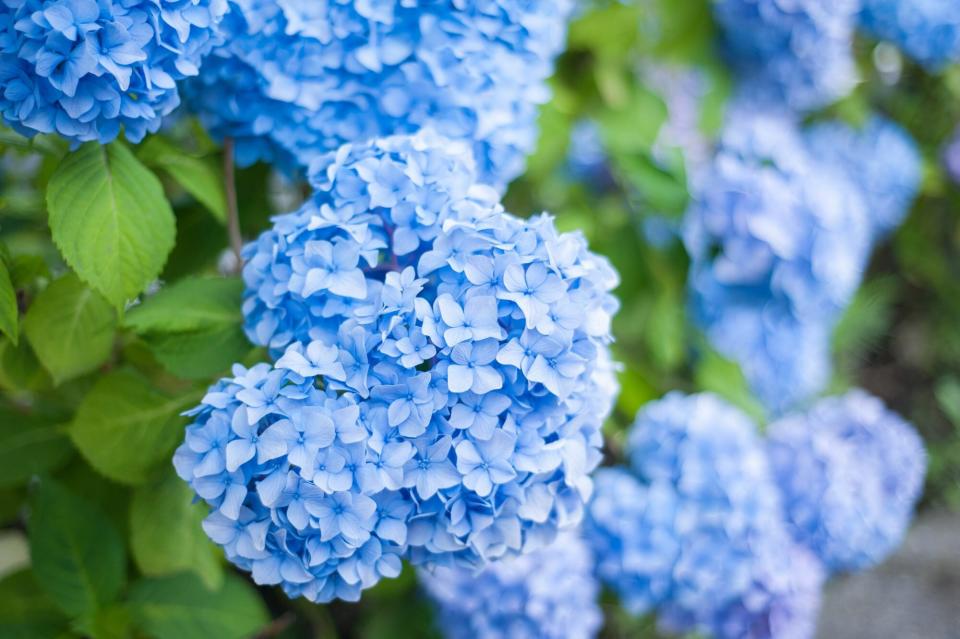A Month-by-Month Hydrangea Care Guide

Hydrangeas are deciduous shrubs that put on a beautiful color show during their blooming seasons. They come in many varieties; some bloom on old wood, while others prefer to flower only after a careful pruning on new wood. For the former, which include panicle hydrangea (H. paniculata) and smooth hydrangea (H. arborescens), Stacey Hirvela, a horticulturist with Proven Winners ColorChoice, notes that you will need to start tending to your plants as early as March. And for the latter? Varieties like bigleaf hydrangea (H. macrophylla), mountain hydrangea (H. serrata), and oakleaf hydrangea (H. quercifolia) require much less work throughout the year.
In the following month-by-month hydrangea care guide, which explains exactly what to do to your favorite flower shrub at the correct time, we asked Hirvela how to tend to both.
Related: A Visual Guide to the Most Popular Hydrangea Varieties

Fishgrill / Getty Images
March
New wood blooming varieties need to be pruned starting in March. Hirvela says you should cut your plant back by about one-third of its total height, snipping just above a set of buds. "Remove any thin, spindly side branches at that time, as well," she says. "This ensures that the growth for the season will be thick, vigorous stems that grow and flower well; it also serves to remove any old flower heads still clinging to the plant." You can also do this with the types that bloom on old wood. "Do not prune these types of hydrangeas any more than what is described here-they have already formed their flower buds for the coming summer and pruning beyond this amount will remove them."
If you live in an area where your soil froze over the winter, Hirvela adds that this is an opportune time to begin a fertilizing routine. She recommends using a granular option specially designed for woody plants (a formula for roses would work well). You can also use this window to transplant your hydrangeas. "It's best to transplant when the plants are still dormant. Save any pruning for after transplanting. That gives you the chance to repair any branches that may have broken during the moving process," Hirvela shares.
April
Continue your monthly fertilizer routine and keep your greenery away from hungry creatures. "If you have deer, protect all plants with a repellent or structure-though deer favor hydrangeas in general, this time of year is particular crucial because they are very hungry and the very tender emerging growth is extra-appealing," she says. If you have a hydrangea variety that changes color based on the pH, Hirvela says now is the time to get your soil tested and apply your additives.
May
If you have an established fertilizer schedule, apply another round now. In May, consider putting down "a good two- to three-inch layer of shredded bark mulch around the roots to keep hydrangeas cool and moist in the coming heat," Hirvela says.
June
In June, your plants will be ready for another round of fertilizer, but extra water will likely be a must now, too. "You may need to begin providing supplemental water at this point if the weather is hot and dry. If these hydrangeas dehydrate severely during their bud development or bloom time, the flowers will turn brown and wilt instead of aging gracefully," Hirvela says of varieties that bloom on new wood. For old wood types, you're in for a treat this month-this is when they typically show their blooms for the first time.
July
You should really begin seeing the fruits of your labor in July, as the varieties that bloom on old wood peak; types that require a heavy pruning to blossom on new wood should also begin to flower. "There is a wide range of show times among both of these hydrangeas, but the earliest-blooming panicle hydrangea, Quick Fire, usually starts around the Fourth of July," she says. While you may be tempted to immediately cut fresh hydrangea flowers to enjoy in a vase, they may wilt if you snip them too early. "It's best to wait until the florets feel slightly dry and papery before beginning to cut," notes Hirvela. Now is also a smart time to deadhead any early bloomers to encourage more growth. Unless, that is, you have smooth and panicle hydrangeas, which develop interesting colors that persist well into fall.
August and September
You shouldn't fertilize your plants after July, so this month, you are free to simply admire your hard work. If you have plans to put together a dried hydrangea craft in the next few months, start clipping. "Cut the flowers of these hydrangeas if you wish to dry them, since they will have matured enough to not wilt right away," Hirvela explains.
October
Your hydrangea has most likely gone dormant at this stage of the year and needs little to no attention. "If your plant developed any leaf spots over the season, it's a good idea to remove and discard the fallen foliage to minimize the chance of reinfection for next year," she says. "Though most leaf spots do not harm the plant in any significant way, they can be a bit unsightly." You can also take this opportunity to add or top off your mulch to maintain a two-to three-inch layer for added winter protection.
November Through February
If you have an old wood blooming variety, your work is done for the season, since it will remain dormant through February. "Flower buds for the following season are already set within the stems, waiting for next summer to bloom again," she says. If you have a hydrangea variety that blooms on new wood, and don't want to look at scraggly branches all winter long, Hirvela says you can cut them now, instead of waiting for March.